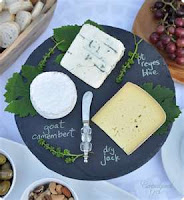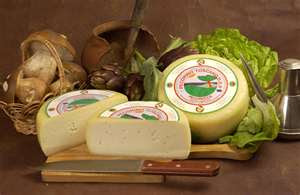
 Several customers have asked about the best way to arrange or set up cheese tasting parties or cheese plates for dinners. So I thought it would help many of our readers if we explained these topics on our blog. As I always note these are our opinions and are not meant to be the final word. I respect differing ideas or thoughts from the ones used here and encourage any comments or other insights to be expressed for the benefits of our readers. So here we go.
Several customers have asked about the best way to arrange or set up cheese tasting parties or cheese plates for dinners. So I thought it would help many of our readers if we explained these topics on our blog. As I always note these are our opinions and are not meant to be the final word. I respect differing ideas or thoughts from the ones used here and encourage any comments or other insights to be expressed for the benefits of our readers. So here we go.ALWAYS ALLOW YOUR CHEESES TO REACH ROOM TEMPERATURE BEFORE SERVING THEM.
Determine how many people will be served and what type of setting you will have( cheese course, wine and cheese tasting, cheeseboard or cheese plate). When this is determined it is easy to calculate the amount of cheese per person. Figure that for an appetizer or a tasting party a three cheese plate will account for about one ounce of each cheese per person for a six cheese setting cut these portions in half. For more substantial settings like a cheese course at dinner or a cheese board consider serving 2 to 2 1/2 ounces per cheese for each person. With these figures you should be able to calculate the amount of cheese to purchase, but you should always add at least and extra 1/2 lb to each of your cheese totals so that you will not be caught short. As the host you can enjoy any of the leftovers the next day.
Cheese Board Set at Amazon
A cheese board or cheese plate is a collection of cheeses that are set out for the purposes of tasting and comparing or as an appetizer course. The cheese board should be composed of a minimum of three and a maximum of six cheeses arranged on a large serving area or plate. The reason for this is that the selection should be diverse enough to comprise cheeses of different countries, milks and textures( ie: soft, hard or semi-hard) but not too many to overwhelm the guests palates. The serving or presentation area should be large enough so that the cheeses do not touch each other or co-mingle while being handled, this will prevent mixing of the aromas and flavors. Precut small portions of each cheese and then let your guests cut their own portions.
 The cheese plate is essentially the same idea except each diner is individually given a small portion of each cheese on his or her plate. For larger gatherings a serving plate with sliced cheese can be presented on each table and the diners can choose their own portions and cheeses. Try to cut the cheeses into interesting shapes such as wedges not just the usual cubes because this will add eye appeal to each plate. When serving cheese as a dinner course present only one or two precut selections and place them on each diners plate. Also be sure to provide your guests with two or three cheese condiments such as olives, fruit, nuts, fruit spreads or jams and of course crusty breads. Wines if offered should represent the same country and region as that of the cheeses.
The cheese plate is essentially the same idea except each diner is individually given a small portion of each cheese on his or her plate. For larger gatherings a serving plate with sliced cheese can be presented on each table and the diners can choose their own portions and cheeses. Try to cut the cheeses into interesting shapes such as wedges not just the usual cubes because this will add eye appeal to each plate. When serving cheese as a dinner course present only one or two precut selections and place them on each diners plate. Also be sure to provide your guests with two or three cheese condiments such as olives, fruit, nuts, fruit spreads or jams and of course crusty breads. Wines if offered should represent the same country and region as that of the cheeses.Wine Glass Set at Amazon
A wine and cheese tasting party should also contain a diverse selection (three to six types) of cheeses but each should be presented separately on its own plate or board. With this in mind we like to create a progression of cheeses to be sampled. This progression can be designed in many ways according to the theme of your party. What we mean here, as an example is suppose you are having a Spanish theme night then the focus would be on Spanish cheeses. So for this you could then choose Spanish cheeses from different types of milk like goat, cow and sheep, or by texture, soft, hard, semi-hard and fresh. The next part is to set up the tasting selections in the order of flavor starting with the mildest and working up to the most flavorful and complex. By doing this you will expose your guests to a series of differing flavors that will build upon each previous one. For instance start with a mild goat milk cheese like Murcia al Vino then move on to Idiazabal a smoked sheep cheese and finally Cabrales a strong blue cheese. When choosing by texture the type of milk is not important so once again go from fresh to soft to hard. You can choose only hard or soft cheeses but then again always go from mild flavor to strong flavor. As noted above, all of your selections should be on individual serving plates or boards. To make everything go a bit smoother precut each cheese into small wedges or cubes but leave a portion of each uncut, this will encourage your guests to cut larger portions of cheeses that they find enjoyable. Be sure to provide a separate knife for each cheese so that the flavors do not get mixed and muddied.
In a future post I will be discussing various cheese condiments and how they can be used to enhance your enjoyment of cheese so stay tuned or subscribe to my feed.
Hopefully all of this does not sound intimidating or seem to be too daunting a task. Just remember that anyone can create a wonderful table presentation with just a little thought and preparation. I suggest strongly that you find a good local or online cheese shop that is willing to help you with your plans and questions. They can provide an invaluable service to you and can make your party a success.







